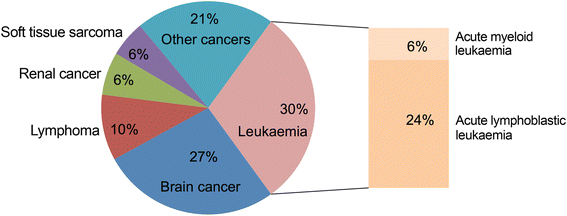Paediatric acute myeloid leukaemia with the t(7;12)(q36;p13) rearrangement: a review of the biological and clinical management aspects
- PMID: 26605042
- PMCID: PMC4657620
- DOI: 10.1186/s40364-015-0041-4
Paediatric acute myeloid leukaemia with the t(7;12)(q36;p13) rearrangement: a review of the biological and clinical management aspects
Abstract
The presence of chromosomal abnormalities is one of the most important criteria for leukaemia diagnosis and management. Infant leukaemia is a rare disease that affects children in their first year of life. It has been estimated that approximately one third of infants with acute myeloid leukaemia harbour the t(7;12)(q36;p13) rearrangement in their leukaemic blasts. However, the WHO classification of acute myeloid leukaemia does not yet include the t(7;12) as a separate entity among the different genetic subtypes, although the presence of this chromosomal abnormality has been associated with an extremely poor clinical outcome. Currently, there is no consensus treatment for t(7;12) leukaemia patients. However, with the inferior outcome with the standard induction therapy, stem cell transplantation may offer a better chance for disease control. A better insight into the chromosome biology of this entity might shed some light into the pathogenic mechanisms arising from this chromosomal translocation, that at present are not fully understood. Further work is needed to improve our understanding of the molecular and genetic basis of this disorder. This will hopefully open some grounds for possible tailored treatment for this subset of very young patients with inferior disease outcome. This review aims at highlighting the cytogenetic features that characterise the t(7;12) leukaemias for a better detection of the abnormality in the diagnostic setting. We also review treatment and clinical outcome in the cases reported to date.
Keywords: Acute myeloid leukaemia; Chromosomal abnormalities; Clinical outcome; HLXB9 gene; Paediatric leukaemia; t(7;12) translocation.
Figures




References
-
- Cancer statistics for the UK: Cancer research UK. [http://www.cancerresearchuk.org/cancer-info/cancerstats/].
-
- Howlader N, Noone AM, Krapcho M, Garshell J, Neyman N, Altekruse SF, et al. SEER Cancer Statistics Review, 1975–2010, Bethesda, MD; National Cancer Institute. http://seer.cancer.gov/csr/1975_2010/
Publication types
LinkOut - more resources
Full Text Sources
Other Literature Sources

